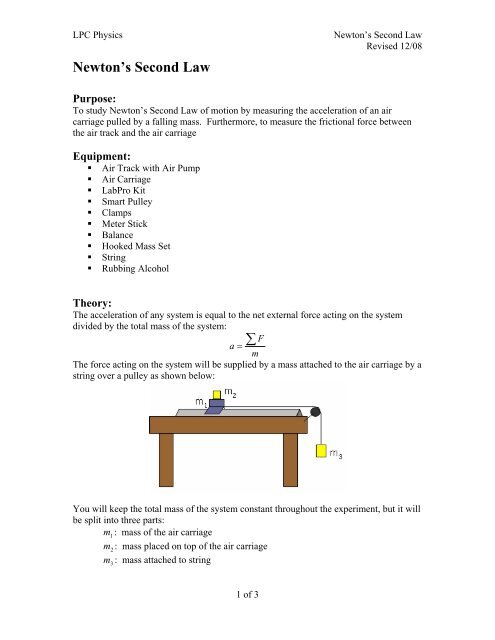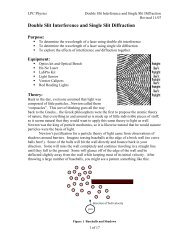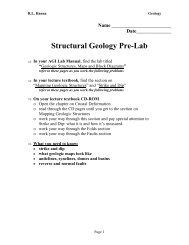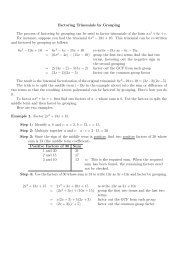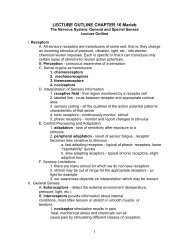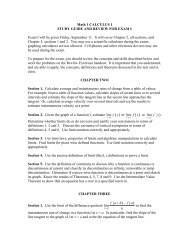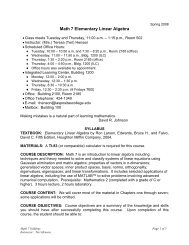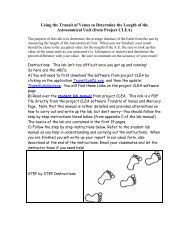Newton's Second Law
Newton's Second Law
Newton's Second Law
You also want an ePaper? Increase the reach of your titles
YUMPU automatically turns print PDFs into web optimized ePapers that Google loves.
LPC PhysicsNewton’s <strong>Second</strong> <strong>Law</strong>Newton’s <strong>Second</strong> <strong>Law</strong>Revised 12/08Purpose:To study Newton’s <strong>Second</strong> <strong>Law</strong> of motion by measuring the acceleration of an aircarriage pulled by a falling mass. Furthermore, to measure the frictional force betweenthe air track and the air carriageEquipment:• Air Track with Air Pump• Air Carriage• LabPro Kit• Smart Pulley• Clamps• Meter Stick• Balance• Hooked Mass Set• String• Rubbing AlcoholTheory:The acceleration of any system is equal to the net external force acting on the systemdivided by the total mass of the system:∑ Fa =mThe force acting on the system will be supplied by a mass attached to the air carriage by astring over a pulley as shown below:You will keep the total mass of the system constant throughout the experiment, but it willbe split into three parts:m 1: mass of the air carriagem 2: mass placed on top of the air carriagem 3: mass attached to string1 of 3
LPC PhysicsNewton’s <strong>Second</strong> <strong>Law</strong>Revised 12/08The quantity m2+ m 3will remain constant—you will vary the force applied to the systemby incrementally moving masses off of the air carriage and onto the end of the string.The force applied to the system is given by = m g . The acceleration is therefore:F3Fm g m ga = 33==m + m + m m + m + m m. Eq. 1123123Experiment:1. Level the air track, using the carriage or a carpenter’s level.2. Using the rubbing alcohol and tissues provided, clean the air track and carts.3. Measure the mass of the air carriage and attach a long string to it.4. Screw a smart pulley into the photogate. Clamp the smart pulley with photogate to theend of the table. Run the string across the pulley and adjust the height of the pulleyso that when the air carriage is on the track, the string is horizontal.5. In addition to the air carriage, you will use a total mass of 200g ( m2 + m3= 200g)To start, attach 30g to the end of the string and place 170g on top of the air carriage( m = 170g , m = 30g2 3). Adjust the length of the string so that the hooked massdoes not hit the ground before the cart reaches the end of the track.6. Set up the Lab Pro by plugging in the AC Adaptor and connecting to the computerwith a USB cable. Connect the photogate to the Lab Pro using a cable that has oneblack end and one white end. Make sure that the tiny slider on the inside of thephotogate is not obstructing the light beam.7. Open the file newtons_second.cmbl (or .xmbl) from the Experiments folder on thedesktop.8. Check to be sure that the photogate is working by passing your hand through thebeam. A red LED should light when the gate is blocked, and its status (located underthe Logger Pro toolbar) should change from “unblocked” to “blocked”.9. If everything seems good, get the cart set on the air track, turn on the air supply, clickthe Collect button, and release the cart. You should see data appearing in the datatable.10. Repeat this measurement 10 times. Each time, use the slope of the velocity vs. timegraph to determine the acceleration.2 of 3
LPC PhysicsNewton’s <strong>Second</strong> <strong>Law</strong>Revised 12/0811. Repeat Steps 9 and 10 for two more values of m 3.Analysis:1. For each mass, determine the average acceleration for the ten trials.2. Determine the uncertainty in this value using the relationship:10∑| a i− aavg|= 1δ aexp= i Eq. 2103. Assuming for a moment that there is no uncertainty in the theoretical value,determine if the experimental value and theoretical values agree within theexperimental uncertainty δa exp .4. Since your values are unlikely to agree in all cases, it is possible that friction shouldbe accounted for. Use your data for acceleration to determine the upper and lowerlimits for the frictional (or resistive) force acting on the carriage from the followingrelation (derive from the 2 nd law and include in your write-up):aexp= atheoryFf m3g− , where atheory=mmThus:F( a − a )( m m )f=theory exp 1+25. From your results, determine how the force of friction depends on mass. Displayyour results graphically if possible. Based on this analysis, determine where in theexperiment the frictional force originates. Support your hypothesis.3 of 3


